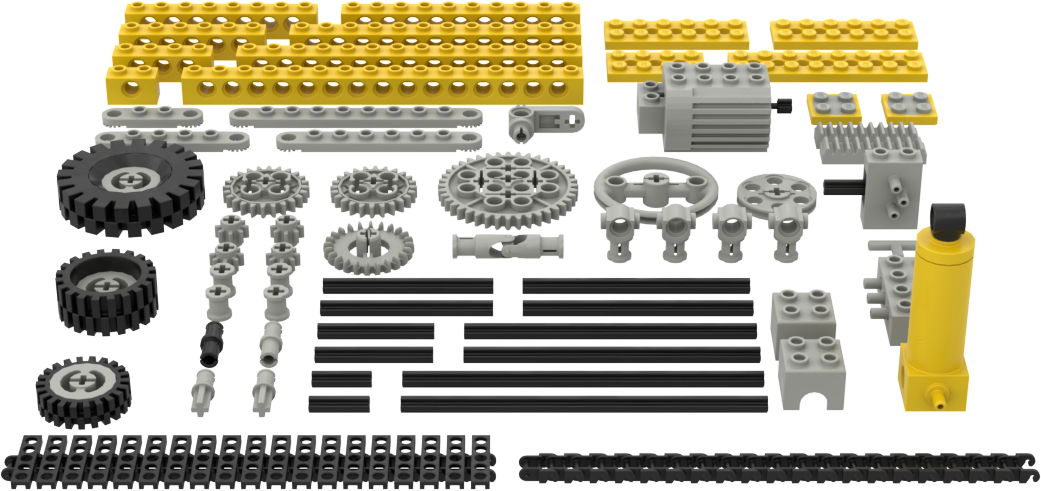Lego Technic

Lego Technic
Lego Technic is a Lego theme. It was introduced in 1977.
As with other themes, it has its own sets, generally sticks to a colour scheme, and introduced various parts.
Unlike other Lego themes, the models you can make, while simplified, actually work.
It's a surprisingly educational toy, and perfect for a child who wants to grow up to be the next Erik Oberg. By messing around with simple yet functional parts, you can intuitively learn firsthand about concepts like inertia, gear ratios, and differentials, by making simplified working models that actually use them.
It's useful for quickly figuring out how physics works and how machines work, through firsthand experimentation. For example, I thought that two pairs of the biggest gears, with horizontal rods connecting them via connectors and pins, would work badly if they were symmetrical; and slightly better if the rods were out of phase by 180°; and much better if they were out of phase by 90° or 270°.
So I tried it out. They were equally bad in phase and 180° out, but they did indeed work great when out by 90° or 270°. The difference was more pronounced than I expected, with no middle ground. Now I know, and because I tried it out myself instead of merely reading about it, I might better remember it.
History
Given how niche their train sets were, Lego's designers were eager to reuse the battery and motor parts elsewhere.[1] In the early 1970s, they released a handful of typically colourful gear sets, complete with axles, bushings, bricks with holes in them, and wheels with chunky tires, alongside the electric motor itself. These were used to make models of machines such as tractors, cranes, and windmills.
Designers Jan Ryaa and Erik Bach[2][3][1] spent the next few years quietly refining this range of parts into its own distinctive theme. In 1977, they patented various related innovations,[2][3][4] and released the first batch of sets using the distinctively redesigned parts.
The new gears were smaller, and the new range of machine parts was more comprehensive. Right off the bat, it included pulleys, crown gears, and even universal gear joints. These refined parts mostly stuck to a more serious industrial colour scheme of black axles, grey gears, and yellow bricks. Overall, it was aimed at a slightly older audience.
Lego introduced three official themes in 1978: Town; Space; and Castle. Each had its own set of parts and distinctive colour scheme. As these more technical sets were clearly in a theme — practically a whole phylum — of their own, they were officially named, appropriately enough, Technical Sets (Expert Builder in the US).
In the early 1980s, this theme was globally renamed to simply Technic, and its range of parts expanded to incorporate intermediate brick sizes, a redesigned battery case, and most significantly, pneumatics.
Eventually, beams (slightly shorter, studless bricks) were introduced, encouraging building inside-out rather than the traditional bottom-up, requiring a reasonable amount of foresight from models' designers, professional and amateur alike.
More and more custom parts specific to a single set were added, until eventually, each Technic set was designed to build one model only, and stay built. But for just over a decade, it was a surprisingly educational toy that let you build a van, tear it apart again, and turn it into a windmill.
Tips
Separating high-friction pins
The instructions of several 1980s Lego Technic sets have on their back page various tips for prising apart stuck parts. The more recent separator is generally preferable.
When removing black high-friction pins, you should push them out from the other side using the axle-shaped part of a separator, or failing that, an actual axle. You should not bite it. Conversely, beware of getting these second-hand, as they will very likely have teeth marks.
There are two very similar looking versions of the black high-friction pin. Beware that the original 1980s version, with longer lines nearer the middle, is very high-friction indeed. In 1990, it was replaced with a revised design, with shorter lines nearer the outer edges, that dialled the friction back to a sensible level.
The brick height

1 ⅔ height = 2 length = 16 mm
As each brick's height is 9.6 mm rather than 8 mm, this causes a problem with connecting gears vertically instead of horizontally. This is simple enough to work around, as 5 plates, or 1 brick and 2 plates, are 16 mm tall, essentially the same as 2 studs. This problem can therefore be solved by adding two plates between each brick.
References
- Chapter 7: Building at the Highest Level Daniel Konstanski, The Secret Life of Lego Bricks, 2022, ISBN 978-1-800-18350-6, pp. 166—197
- "Connector and Bearing for Swingably Mounting Rod" Erik Bach, Jan Ryaa, US Patents, 1977
- "Gear Wheel for Toy Building Sets" Erik Bach, UK Patents, 1977
- "Rotatable Element for Toy Building Sets" Erling T. Dideriksen, US Patents, 1977
Further reading
Encyclopedias
- "Blakbird's Technicopedia" Blakbird
Deep dives
- Chapter 7: Building at the Highest Level Daniel Konstanski, The Secret Life of Lego Bricks, 2022, ISBN 978-1-800-18350-6, pp. 166—197
Downloads
Documentation
Patents
- "Connector and Bearing for Swingably Mounting Rod" Erik Bach, Jan Ryaa, US Patents, 1977
- "Gear Wheel for Toy Building Sets" Erik Bach, UK Patents, 1977
- "Rotatable Element for Toy Building Sets" Erling T. Dideriksen, US Patents, 1977
Lego themes: BrickHeadz | Lego Basic | Lego Creator | Lego Homemaker | Lego Technic | Lego Town Plan | Legoland | Universal Building Set
Lego Technic: Lego Technic parts | Lego Technic sets

